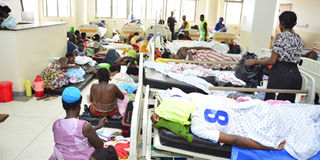Prime
Maternal and child health: Dealing with congestion

Congested. Some mothers sleep on the floor because of congestion at Kawempe Referral Hospital in 2016. The facility was elevated to a referral status, the level of a health centre IV, in a move to decongest the national referral hospital and the Mulago Specialised Women and Neonatal Hospital. FILE PHOTO
What you need to know:
Overwhelmed. In many, if not all government hospitals, it is very common to find two or three babies occupying an incubator or baby bed. Lilian Namagembe explores how the authorities are dealing with the situation.
The congestion at the children’s special care unit at Kawempe Referral Hospital, which has been the talk of many, especially on social media in the past weeks, paints a typical picture of encounters at most, if not all, government hospitals.
It is very common to find two or three babies occupying an incubator or baby bed at the hospital’s neonatal intensive care unit (NICU), something doctors say exposes them to various infections.
Disturbing picture of babies receiving care on hospital beds and plastic chairs went viral on various social media platforms, especially Facebook, something the hospital attributes to the overwhelming number of referrals.
At the moment, Dr Lawrence Kazibwe, the hospital’s acting deputy director, says the hospital receives most of the mothers from lower health facilities around Kampala, Wakiso, Mukono districts and other parts of the country.
“So even if we get more beds, where shall we put them? The number keeps increasing every day,” Dr Kazibwe says, adding that their duty is to offer treatment regardless of where one comes from.
The same condition was sighted at Naguru General Hospital’s neonatal special care unit, where children in critical condition are admitted. Similarly, although the hospital receives 30 expectant mothers every 24 hours, the ward has only 25 beds.
Some mothers who deliver from Naguru General Hospital in Nakawa Division, Kampala, are forced to sleep on the floor after delivering because the beds are not enough, which exposes them to various infections, the doctors say.
Before the start of its refurbishment and upgrading in 2014, the situation at Mulago National Referral Hospital was worse in the women’s delivery section where patients occupied all the beds, the floor and the corridors.
Although the hospital had been constructed to admit 1,500 patients, it admitted 2,500, a situation that was compounded with the high number of patient attendants. As a result, the number of people in each ward is always more than twice what the space was designed for.
Interventions
It is upon this background that Kawempe Referral Hospital, which exclusively handles maternal health services, was elevated to a referral status, the level of a health centre IV, as a move to decongest the national referral hospital and the Mulago Specialised Women and Neonatal Hospital.
“Patients accessing the services should be referred patients from our referral facilities, except those that are exclusively offered at Mulago Specialised Women and Neonatal Hospital such as IVF and laparoscopic surgery,” Dr Jane Ruth Aceng, the Health minister, says.
The Ministry of Health has also since started upgrading 125 health centre IIs, which merely offer outpatient services, to health centre IIIs, which run a general outpatient clinic and a maternity ward to reduce the numbers at referrals and the subsequent congestion.
With the completion of the project, Dr Aceng says government will be able to revive the referral system when the lower facilities are functional.
With such interventions, government hopes to reduce maternal mortalities, which remain high at 336 per 100,000 live births compared to the global rate of 216 per 100,000 live births.
Similarly, the under-five mortality ratio currently stands at 64 deaths per 1,000 live births in Uganda.
However, the revival of the referral system seems to have flopped already as mothers with ordinary maternal cases, flock referral hospitals for as long as they can afford the prices, contrary to the minister’s earlier idea to leave the hospitals to handle only complicated cases referred to them from lower health centres.
Health experts speak out
Experts in the health sector have expressed the need for government to invest more resources in the health sector so that services are extended nearer to the communities.
Prof Francis Omaswa, the executive director of the African Centre for Global Health and Social Transformation (ACHEST), attributes congestion at health facilities to two factors; high population growth rate and poor mobilisation resources.
“For health, the most important thing is to put more money in health budgets and initiatives such as the insurance schemes. The health insurance scheme will work depending on how it is managed,” Prof Omaswa says.
Findings in the latest Annual Health Accounts (NHA) study by the Health ministry indicate that government, on average, spends Shs3,000 on provision of healthcare services to each citizen per month.
As a result, the report notes that more Ugandans have turned to the more expensive private health facilities for services, pushing up the cost of healthcare access.
The experts have also urged government to ensure the consistent functional referral system so that the referral hospitals are left to perform their intended roles of handling complex cases only.
Ms Robinah Kaitiritimba, the executive director of Uganda National Health Consumers’ Organisation (UNHCO), says people have no confidence in lower health facilities that are ill-equipped, poorly staffed, with no medicine and one has to wait for longer hours before getting services.
“If one was confident that one’s problem would be solved at the lower health centre one would have no reason to go to the referral centres,” Ms Kaitiritimba.




